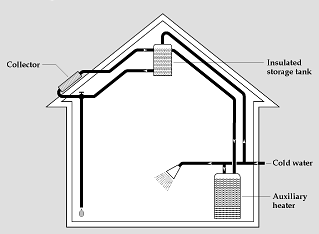Thermosyphon Solar Water heaters
Whenever you see a solar panel with a cylinder immediately above it, you are probably looking at a thermosyphon solar water heater. These heaters are simple and reliable, and the most common solar water heaters worldwide.
How thermosyphon systems work
Typical thermosyphon heaters do not have pumps or controls; they are based on the natural convection principle: hot water rises, cold water sinks.
As the potable water (or the antifreeze fluid, in colder climates) enters into the solar panel, it warms and rises to the top of the tank, where it is stored (that’s the reason why thermosyphon cyllinders are located above the collector).
Thermosyphon systems highlights
» Thermosyphon systems are simple and reliable;
» They are very inexpensive in countries like China or Israel;
» They are mostly intended for climates without freezing temperatures;
» In cold climates, consider drainback
solar
heaters as an alternative.
Thermosyphon & Collectors
Thermosyphon systems can be equipped with either tube solar panels or flat solar panels.
Advantages
Thermosyphon systems are cheap, reliable and since they do not have pumps or controls they do not require any significant maintenance.
Contrary to batch systems - and since hot water is stored in an insulated tank - they are able to minimize heat loss during the nighttime hours.
 Image: EERE
Image: EERE
Disadvantages
Thermosyphon systems will stop functioning if outdoor temperatures drop below the freezing point and stay there for significant periods; they have to be drained to function properly again.
They are mostly intended for moderate and hot climates. They may not function properly in cold climates, in freezing temperatures.
To overcome this limitation manufacturers are equipping their thermosyphon models with small circulating pumps that are turned on in freezing weather, to move water and to prevent it from freezing.
Weight can also be a disadvantage; a tank full of water is an heavy object, and may require some sort of reinforcement of the roof structures.
Installation
Thermosyphon systems are easy to install and to connect to existing hot water piping; the installation involves a cold water supply line, a cold water inlet and a hot water outlet...
Prices
Thermosyphon systems are relatively inexpensive. In the US you may find a 40 gallons thermosyphon kit with a tube solar collector (standard 20 tubes) at prices around $1,000-$1,200.
A larger system (80 gallons) with a 20 tube solar panel may cost you $1,200-$1,500, but installation costs can run up to more than the cost of the collectors and hardware.
See: Solar Water Heaters Prices and Paybacks
![]() Related Content
Related Content
![]() Top .... Home Page
Top .... Home Page


